By Mark Tuttle, photography by Arnold Debus
If you live in a large city, it doesn’t take much thought to figure out why BMW is jumping into the scooter market now. Traffic congestion and parking restrictions are escalating, and in the new economy some of us just can’t afford to waste time with either—we need to get there, dang it, and ASAP. With their twist-and-go automatic CVT transmissions and knees-together, step-through seating, scooters offer a non-intimidating transition to the narrow nimbleness of powered, single-track two wheelers, returning freedom and mobility to the caged urban warrior—if he or she is willing to forgo the creature comforts of a car.
Of course, if mobility was BMW’s only motivation, it might have launched its new scooter line with a smaller, more fuel-efficient type rather than these two big “maxis” (as they’re commonly called in Europe). After all, there’s at least one late-model car in the U.S. that bests the C 600 Sport’s and C 650 GT’s rated 49 mpg highway (their engines and drivetrains are identical). And while certainly smaller and more nimble than any car, at a claimed 549 and 575 pounds ready to ride with a 62.6-inch wheelbase, the Sport and GT are bigger than many motorcycles.
What the C maxis offer that a smaller scoot cannot is an exciting alternative for a customer BMW might otherwise lose. An RT or GS rider, for example, who for whatever reason needs a less top-heavy bike he or she doesn’t have to shift or swing a leg over—but who is not willing to give up the power, handling and exhilaration of a motorcycle.
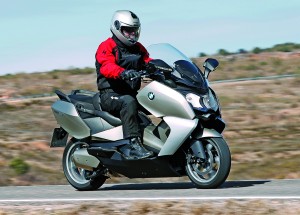
After two days of riding the C 600 Sport and C 650 GT in and around Madrid, Spain, I can assure you that the owner of one would enjoy it a lot and give up little. Hiding under all of that plastic are really 647cc motorcycles with a claimed 60 horsepower and 49 lb-ft of torque at the crank—more power than anything with an automatic CVT transmission sold here save the Aprilia Mana 850. The two scooters accelerate briskly and cruise at high speed…like motorcycles. Strong triple-disc brakes with standard ABS stop large-diameter (for a scooter) 15-inch wheels at each end wearing Metzeler or Pirelli sport-touring tires, which help give the scooters agile steering and hard cornering ability…like a motorcycle. And standard or optional equipment such as adjustable windscreens—electric on the GT—heated seats and grips, trip computers, GPS navigation and more kit them out…like a motorcycle. Well, like a BMW motorcycle, anyway.
The Sport was called a 600 to make it seem lighter and sportier, yet underneath the bodywork the only differences between BMW’s two new scoots are a stronger seat subframe and Metzeler Feelfree tires on the plush, touring-oriented GT (a “maxi” scooter with “feel-free” tires, hmmm), while the Sport has Pirelli Diablo Scooter tires. Both are built at BMW’s Berlin, Germany, plant and are powered by a BMW-designed and engineered, parallel twin-cylinder engine manufactured by Taiwan-based Kymco, which has vast mega-scooter experience and production capacity.
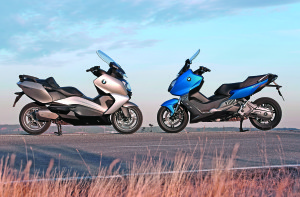
The liquid-cooled, fuel-injected, 647cc, chain-driven DOHC (shim over bucket) twin is most notable for its long, flat layout with a 70-degree inclined cylinder bank, which gives the scooters a low center of gravity. It also has crankpins that are offset 90 degrees (rather than the usual 180 or 360) and ignition at 270 degrees for a sporty feel and sound, with dual counterbalancers to cancel vibration. A centrifugal clutch engages the CVT, comprising two pulleys connected by a thick V-belt. As engine speed changes, one pulley widens and the other narrows, moving the belt toward or away from the center of each and raising or lowering the gear ratio. Power gets to the rear wheel through a chain enclosed in an oil bath in the aluminum single-sided swingarm. We’ll have more details on maintenance later, but I did find out that the CVT belt needs attention and possible replacement at 20,000 kilometers, or 12,427 miles.
BMW BMS-E fuel-injection delivers the charge of mid-grade 89 octane from a 4.2-gallon tank just ahead of the scooters’ seats. A motorcycle-worthy aluminum bridge-type frame supports the engine as a stressed member, and there’s a stout male-slider fork up front and a horizontally mounted single shock in back that’s adjustable for spring preload. Both have centerstands, and sidestands that automatically engage the parking brake when deployed. This made for a bit of entertainment as we tried to jockey the bikes around in the hotel garage before for our first day’s ride—a “city tour” of Madrid, Spain’s capital as well as its largest and youngest major city at a mere 1,000 years old.
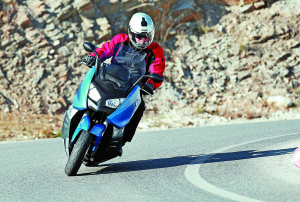
Appropriately BMW started us off on the C 600 Sport model, as the city tour turned out to be a demonstration of just how capable this scooter is of making minced jamon out of Madrid’s heavy and somewhat chaotic traffic. With one yellow-vested, motorcycle-mounted BMW guy in front and another behind, our gang of scooter journalists dodged, weaved and filtered among the cars, buses and dozens of solo and two-up scooter pilots, all seemingly fighting for the lead in Spain’s rat race. After 90 minutes we covered more of the city than the average car driver must see in a year. Scooters rule the streets and are everywhere, carrying everybody from businessmen and women (their suits protected from grime by accessory lap covers, even in the 80-degree weather) to daring young girls delivering pizza stowed in large top trunks on the back of tiny two-stroke scoots. BMW says that 70-75 percent of its sales volume for the Sport and GT is expected to be in Southern Europe, where this mode of transportation is the most popular outside of Asia.
While identical at their cores, the Sport shaves off 26 pounds of equipment and has narrower bodywork than the GT, so it can squeeze between cars and offers a firmer, sportier ride. Its tall, protective windscreen is manually adjustable over about an 8-inch range and is very quiet when up; mirrors are simple affairs on tall stalks and the dual seat is narrower, though still quite comfortable. The Sport’s bars are lower and narrower as well, and leg room is tighter—my knees were still bent with my feet on the angled floorboards in front. The slimmer fairing’s pair of latching pockets are proportionally smaller than the GT’s too. A drop-down “Flex Case” in the Sport’s underseat storage allows just enough space for two full-face helmets when parked, but the Flex Case must be raised to ride. For the city commuter or where parking space is a problem, the Sport is probably a good choice.

When the road stretches out, as on our ride in the countryside and mountains around Madrid the next day, the C 650 GT is the way to go. Plush, comfortable and with lots more leg room, its fairing and electric windscreen provided generous wind protection in the cold, snowy mountains at 5,000 feet. The GT’s 60-liter underseat storage holds two full-face helmets, its wide dual seat has an adjustable rider backrest and the mirrors are bigger, adjust within and incorporate beautiful LED turn signals. Most importantly the GT’s handlebar is wider and higher and its seat a little lower, which makes it more comfortable and able to steer more easily and quickly, even though you can feel its additional weight once in a corner. Since I could maneuver it just as well if not better than the Sport on the mountain roads and don’t need to squeeze between anything except my jacket zippers where I live, the GT would be my choice for its comfort and convenience features.
Besides their smooth, brisk power, throaty sound and dynamic handling, the scooters’ high-end, functional suspension and non-linked, triple-disc brakes with standard ABS elevate these BMWs from dorky scooter to motorcycle serious. Both brake levers are adjustable (there’s no clutch lever or brake pedal, eh), instrumentation is comprehensive and the GT’s electric windscreen rises well over my head to form an almost still pocket of air behind. The options on our test bikes like heated grips and seats, GPS navigation and a tire pressure monitor worked well, and are just the beginning of a list that includes luggage, communication and alarm system, even an Akrapoviˇcćmuffler as well as three color choices for each. After this short test session my only concern is the seat heights, which at 30.7 (GT) and 31.9 inches put me on my tiptoes at stops, kind of a contradiction for much of their intended market. I imagine BMW will offer lower seats eventually, but none are on the options list. The GVWR for both is the same, so the Sport actually has the higher load capacity of 432 pounds, the GT 406.

Current pricing for the C 600 Sport and C 650 GT in Germany is 11,100 and 11,450 euros respectively, which sounds high, but the venerable Suzuki Burgman 650 Executive is listed at 10,290 euros for 2012 on Suzuki Germany’s website ($9,899 here). BMW expects its scooters to be “priced competitively with the U.S. maxi-scooter market,” though a production delay—perhaps due to the Japanese earthquake in 2011—and of course high European demand will keep them from coming here until the fall of 2012, so they will likely be 2013 models.
Wow, 2013—sounds like way in the future, doesn’t it? It’s easy for a fit motorcycle enthusiast who lives and works in the country or ’burbs to poke fun at scooters. From the point-of-view of an older rider who just wants to stay on two wheels or a city dweller who needs shiftless convenience, storage and agility, however, these motorcycle-like BMWs may represent the future.
BMW C 600 Sport / 650 GT
Website: bmwmotorcycles.com
Base Price: TBD
Engine Type: Liquid-cooled, transverse parallel twin, DOHC, 4 valves per cyl.
Bore x Stroke: 79.0 x 66.0mm
Displacement: 647cc
Transmission: Continuously Variable (CVT)
Final Drive: Enclosed chain in oil bath
Wheelbase: 62.6 in.
Rake/Trail: 25.4 degrees/3.6 in.
Seat Height: 31.9 / 30.7 in.
Claimed “Road Ready” Weight: 549 / 575 lbs.
Fuel Capacity: 4.2 gals., last 1.1 gal. warning light on
Claimed MPG: (89 PON min.) 49 at 62 mph

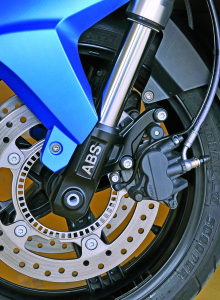
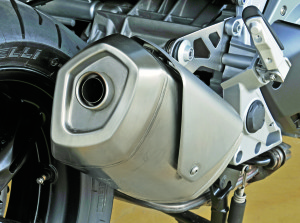
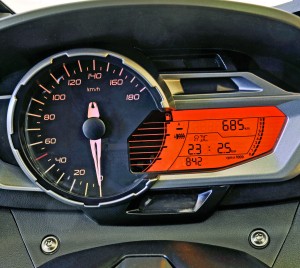
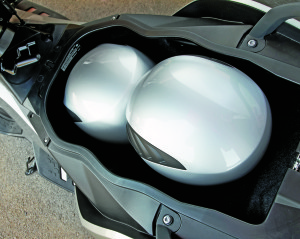
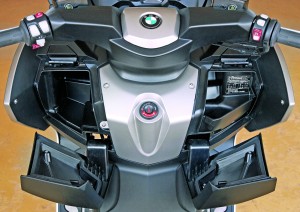
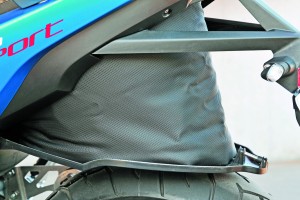
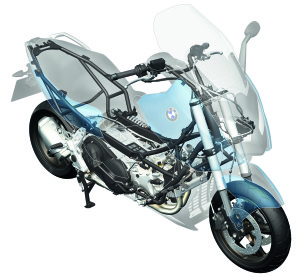
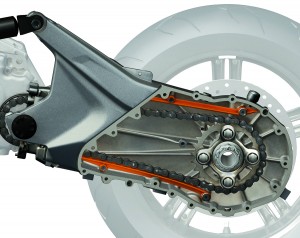
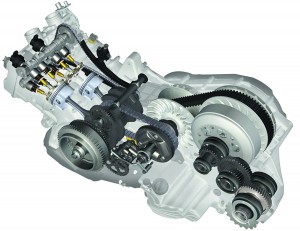









does it takes sidepanniers?how about a topbox,or rack?on the back ;Price in australian dollars?
Looks like they copied my Suzuki Burgman 650, only with a less complex transmission system
What is the top speed for the new bmw c 600, and the gt 650 scoots. How does bmw scoots compare to the new 2012-13 TMAX on top speed. Also can you put on a carrying case on top of either the 600, or the bmw 650, scooters.
Why does the 650 GT and the sport 650 have such high compression in the cylinders, 11 1/2 , that’s why they require 91 or higher fuel which is not very cheap nowadays.
High comp. is required in racing engines, dragsters, Indi cars ect. At freeways speeds 65 to 70 mph what rpm is the engine churning.
When Pulling long steep grades packing double what kind of slippage is taking place in the clutch assy. And the cvt transmission, how often does the drive belt have to be replaced?
Thank you for your time……jarold.owen@yahoo.com…..
Why does the 650 GT and the sport 650 have such high compression in the cylinders, 11 1/2 , that’s why they require 91 or higher fuel which is not very cheap nowadays.
High comp. is required in racing engines, dragsters, Indi cars ect. At freeways speeds 65 to 70 mph what rpm is the engine churning.
When Pulling long steep grades packing double what kind of slippage ist taking place in the clutch assy. And the cvt transmission, how often does the drive belt have to be replaced?
Thank you for your time……jarold.owen@yahoo.com…..
Hello
Please can you give me a price for a motorcycle:
Scooters: BMW C 600 Sport and C 650 GT
Thanks
They’re no longer in BMW’s U.S. lineup.